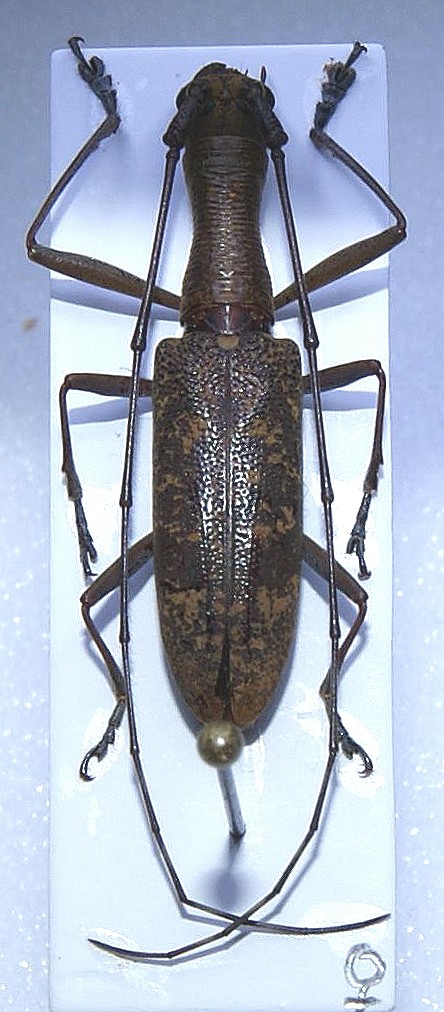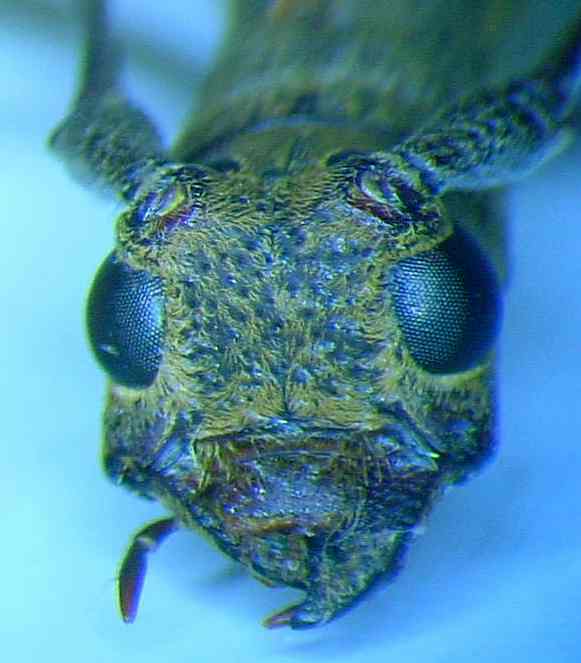| Author |
 Topic Topic  |
|
|
Andre
Member Rosenbergia
   
Germany
1730 Posts |
 Posted - 15/10/2012 : 15:15:06 Posted - 15/10/2012 : 15:15:06



|

Gnoma longicollis ?
Borneo Trus Madi, Female, 21 mm. |
|
|
Francesco
Forum Admin
    
Luxembourg
9511 Posts |
 Posted - 20/01/2013 : 18:59:34 Posted - 20/01/2013 : 18:59:34




|
According to Breuning the only two species with this kind of pubescence present in Borneo are Gnoma confusa Thomson, 1865 and G. subfasciata Thomson, 1865.
They differ in the size of the under eye lobes, much longer than cheeks (confusa) or as long as (subfasciata).
According to Dillon & Dillon (1951), the former is synonym of G. longicollis (Fabricius,1787) and the latter of G. sticticollis Thomson,1857... nevertheless, contrary to Breuning, these authors (as usual   ) did not see Thomson's types. Hence, their synonymies are only speculations. ) did not see Thomson's types. Hence, their synonymies are only speculations. |
 |
|
|
dryobius
Member Rosenbergia
   
USA
1889 Posts |
 Posted - 21/01/2013 : 00:51:39 Posted - 21/01/2013 : 00:51:39



|
In 1999, Hudepohl identified my specimens of this Bornean species as G. longicollis. I have not questioned this determination, but occasionally he made a mistake too.
For the moment, I still call this G. longicollis, too. I have seen quite a few specimens of this species over the years (20 or 30 from Borneo and 1 from Perak) and they are very stable and consistent in their coloration and pattern of maculation on the elytra.
It would be fantastic to get a photo of the holotype. That way we could know for sure. Since the type locality is not Borneo, we can only guess. |
 |
|
|
Francesco
Forum Admin
    
Luxembourg
9511 Posts |
 Posted - 21/01/2013 : 19:52:50 Posted - 21/01/2013 : 19:52:50




|
The use of G. longicollis is extremely doubtful.
Both revisers (Breuning and the Dillons) did non know Fabricius' type; moreover, this species came from "India orientalis" a very generic provenance.
Nonetheless, both agree on the fact that this species is characterised by "front finement ponctué" (Breuning) or "front rather sparsely" punctate" (Dillons).
But, both Gnoma confusa (Borneo) and G. subfasciata (Java) have a "front grossièrement ponctué".
This is certainly, since both Thomson's types are preserved in Paris, where Breuning lived.
On the contrary, we know that the Dillons did not see such types (as many other ones preserved in Paris).
Therefore, Dillons' synonymy- longicollis = confusa is surreptitious (opposite characters).
- subfasciata Thomson = sticticollis Thomson is hazardous for many reasons. In fact, both species were described by the same author (who was a specialist!), both were verified by Breuning, and both were not seen by the Dillons.
|
 |
|
|
dryobius
Member Rosenbergia
   
USA
1889 Posts |
 Posted - 21/01/2013 : 21:37:55 Posted - 21/01/2013 : 21:37:55



|
The case with this genus is the same problem as many others. "India orientalis" could mean East Indies ( ?Indonesia ) or anywhere within 4000 kilometers!!
Many genera from the Orient need revisions where somebody actually looks at the holotypes. It is a shame that much of the work published by Bruening, Dillon and others was without quality research.
For me, since Hudepohl identified my specimens (correctly or not), I will use that name until I see something published which can dispute his determination. |
 |
|
|
Francesco
Forum Admin
    
Luxembourg
9511 Posts |
 Posted - 21/01/2013 : 22:06:29 Posted - 21/01/2013 : 22:06:29




|
| In all cases... Andrea could you insert a frontal picture of the head? |
 |
|
|
Andre
Member Rosenbergia
   
Germany
1730 Posts |
 Posted - 21/01/2013 : 22:50:28 Posted - 21/01/2013 : 22:50:28



|

It's tragic, also by Gnoma such a confusion.
Here a picture from the head.
Thank you for your extensive consultation. |
 |
|
|
Francesco
Forum Admin
    
Luxembourg
9511 Posts |
 Posted - 22/01/2013 : 10:08:57 Posted - 22/01/2013 : 10:08:57




|
So!
The under eye lobes are as long as cheeks (certainly not "much longer than cheeks").
By using Breuning's monograph, this species should be identified as G. subfasciata.
By using Dillons' monograph I do not reach G. sticticollis (= subfasciata) but G. longicollis.
In fact the "maculation" is not "finely reticular, rather sparse, nearly white in color", but "coarse and dense, often fulvous or ochraceus".
Therefore, the synonymy subfasciata = sticticollis should be erroneous. |
 |
|
| |
 Topic Topic  |
|


